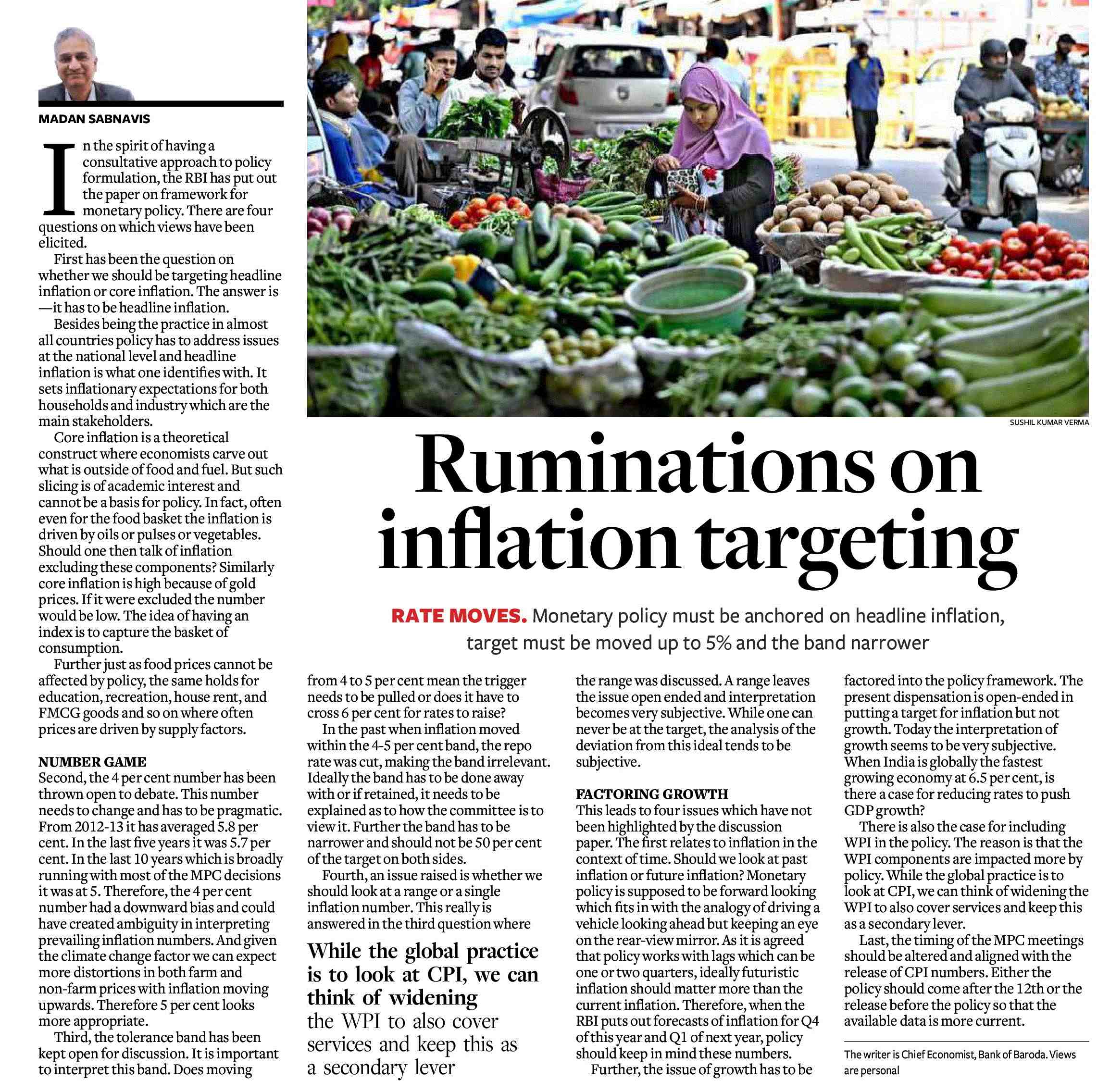Ruminations on inflation targeting
MADAN SABNAVIS
In the spirit of having a consultative approach to policy formulation, the RBI has put out the paper on framework for monetary policy. There are four questions on which views have been elicited.
First has been the question on whether we should be targeting headline inflation or core inflation. The answer is -it has to be headline inflation.
Besides being the practice in almost all countries policy has to address issues at the national level and headline inflation is what one identifies with. It sets inflationary expectations for both households and industry which are the main stakeholders.
Core inflation is a theoretical construct where economists carve out what is outside of food and fuel. But such slicing is of academic interest and cannot be a basis for policy. In fact, often even for the food basket the inflation is driven by oils or pulses or vegetables. Should one then talk of inflation excluding these components? Similarly core inflation is high because of gold prices. If it were excluded the number would be low. The idea of having an index is to capture the basket of consumption.
Further just as food prices cannot be affected by policy, the same holds for education, recreation, house rent, and FMCG goods and so on where often prices are driven by supply factors.
NUMBER GAME
Second, the 4 per cent number has been thrown open to debate. This number needs to change and has to be pragmatic. From 2012-13 it has averaged 5.8 per cent. In the last five years it was 5.7 per cent. In the last 10 years which is broadly running with most of the MPC decisions it was at 5. Therefore, the 4 per cent number had a downward bias and could have created ambiguity in interpreting prevailing inflation numbers. And given the climate change factor we can expect more distortions in both farm and non-farm prices with inflation moving upwards. Therefore 5 per cent looks more appropriate.
Third, the tolerance band has been kept open for discussion. It is important to interpret this band. Does moving from 4 to 5 per cent mean the trigger needs to be pulled or does it have to cross 6 per cent for rates to raise?
In the past when inflation moved within the 4-5 per cent band, the repo rate was cut, making the band irrelevant. Ideally the band has to be done away with or if retained, it needs to be explained as to how the committee is to view it. Further the band has to be narrower and should not be 50 per cent of the target on both sides.
Fourth, an issue raised is whether we should look at a range or a single inflation number. This really is answered in the third question where
While the global practice is to look at CPI, we can think of widening the WPI to also cover services and keep this as a secondary lever the range was discussed. A range leaves the issue open ended and interpretation becomes very subjective. While one can never be at the target, the analysis of the deviation from this ideal tends to be subjective.
FACTORING GROWTH
This leads to four issues which have not been highlighted by the discussion paper. The first relates to inflation in the context of time. Should we look at past inflation or future inflation? Monetary policy is supposed to be forward looking which fits in with the analogy of driving a vehicle looking ahead but keeping an eye on the rear-view mirror. As it is agreed that policy works with lags which can be one or two quarters, ideally futuristic inflation should matter more than the current inflation. Therefore, when the RBI puts out forecasts of inflation for Q4 of this year and Q1 of next year, policy should keep in mind these numbers.
Further, the issue of growth has to be factored into the policy framework. The present dispensation is open-ended in putting a target for inflation but not growth. Today the interpretation of growth seems to be very subjective. When India is globally the fastest growing economy at 6.5 per cent, is there a case for reducing rates to push GDP growth?
There is also the case for including WPI in the policy. The reason is that the WPI components are impacted more by policy. While the global practice is to look at CPI, we can think of widening the WPI to also cover services and keep this as a secondary lever.
Last, the timing of the MPC meetings should be altered and aligned with the release of CPI numbers. Either the policy should come after the 12th or the release before the policy so that the available data is more current.
The writer is Chief Economist, Bank of Baroda. Views are personal

